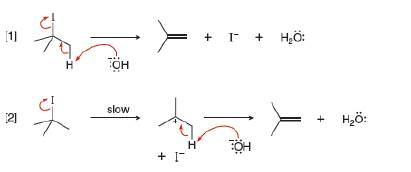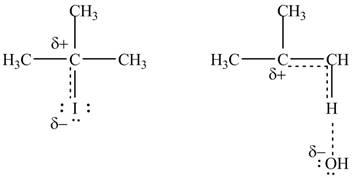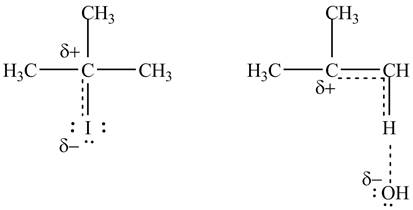
The conversion of

a. What rate equation would be observed for the mechanism in Equation [1]?
b. What rate equation would be observed for the mechanism in Equation [2]?
c. What is the order of each rate equation (i.e., first, second, and so forth)?
d. How can these rate equations be used to show which mechanism is the right one for this reaction?
e. Assume Equation [1] represents an endothermic reaction and draw an energy diagram for the reaction. Label the axes, reactants, products,
f. Assume Equation [2] represents an endothermic reaction and that the product of the rate-determining step is higher in energy than the reactants or products. Draw an energy diagram for this two-step reaction. Label the axes, reactants and products for each step, and the
(a)
Interpretation: The rate equation for the mechanism in Equation [1] is to be stated.
Concept introduction: The rate equation is given as,
The order of reaction depends on the exponents
The rate equation for the reactions in which rate of a reaction depends on one reactant only is given as,
Answer to Problem 6.53P
The rate law equation for the mechanism in Equation [1] is given as,
Explanation of Solution
The mechanism of Equation [1] is shown below.

Figure 1
The above reaction occurs in one step. The hydroxide ion attacks on proton of the starting material. As a result, new double bond formed between two carbon atoms. Iodide ion is expelled out as a leaving group. Therefore, the rate of the reaction relies on the concentration of the starting material and as well as nucleophile. The rate equation for this mechanism is given as,
(a) The rate equation for the mechanism in Equation [1] is given as,
(b)
Interpretation: The rate equation for the mechanism in Equation [2] is to be stated.
Concept introduction: The rate equation is given as,
The order of reaction depends on the exponents
Answer to Problem 6.53P
The rate equation for the mechanism in Equation [2] is given as,
Explanation of Solution
The mechanism of Equation [2] is shown below.

Figure 2
The above reaction occurs in twosteps. In the first step,
Therefore, the rate of the reaction relies on the concentration of the starting material. The rate equation for this mechanism is given as,
The rate equation for the mechanism in Equation [2] is given as,
(c)
Interpretation: The order of each rate equation is to be identified.
Concept introduction: The rate equation is given as,
The order of reaction depends on the exponents
Answer to Problem 6.53P
Theorder of first rate equation is second and the order of second rate equation is first.
Explanation of Solution
The rate law equation for the mechanism in Equation [1] is given as,
The rate equation implies that rate of a reaction relies on the concentration of the starting material and nucleophile. Therefore, it is a second ordered rate equation.
The rate equation for the mechanism in Equation [2] is given as,
The rate equation implies that rate of a reaction relies on the concentration of the starting material only. Therefore, it is a first ordered rate equation.
The order of first rate equation is second and the order of second rate equation is first.
(d)
Interpretation: The use of rate equations to describe which mechanism is the right one for the given reaction is to be stated.
Concept introduction: The rate equation is given as,
The order of reaction depends on the exponents
The rate equation for the reactions in which rate of a reaction depends on one reactant only is given as,
Answer to Problem 6.53P
The equation [2] is the right one for the given mechanism because it involves two steps to complete the reaction.
Explanation of Solution
The equation showing the right mechanism is,

Figure 3
In the above reaction, the starting material is tertiary alkyl halide. In the first step,
Therefore, the equation [2] is the right one for the given mechanism.
The equation [2] is the right one for the given mechanism because it involves two steps to complete the reaction.
(e)
Interpretation: An energy diagram and the structure of the transition state are to be drawn by assuming Equation [1] as an endothermic reaction. The axes, reactants, products,
Concept introduction: The transition state is formed during the conversion of reactants into products in the chemical reaction. In an energy level diagram, it corresponds to the high potential energy along the y-axis. In this state, the dashed bond implies that bonds are partially broken and partially formed in the reaction.
Answer to Problem 6.53P
An energy diagram and the structure of the transition state by assuming Equation [1] as an endothermic reaction is drawn in Figure 4 and Figure 5 respectively The axes, reactants, products,
Explanation of Solution
An energy diagram in which Equation [1] is considered as endothermic reaction is drawn as,

Figure 4
In the energy diagram, reaction coordinate is represented by x-axis and energy is represented by y-axis. The reaction coordinate describes the progress of the reaction. The energy of starting material is low in the diagram as compared to the energy of the product, which indicates that this reaction is endothermic. The minimum energy that is required to form the product from the starting material is represented by
The structure of transition state is,

Figure 5
The transition state is formed during the conversion of reactants into products in the chemical reaction. This state cannot be isolated. The dashed bond indicates that bonds are partially broken or formed during the reaction.
An energy diagram and the structure of the transition state by assuming Equation [1] as an endothermic reaction is drawn in Figure 4 and Figure 5 respectively The axes, reactants, products,
(f)
Interpretation: An energy diagram and the structure of the transition state are to be drawn by assuming Equation [2] as an endothermic reaction and the energy of product of the rate-determining step is higher than the reactants or products. The axes, reactants, products,
Concept introduction: The transition state is formed during the conversion of reactants into products in the chemical reaction. In an energy level diagram, it corresponds to the high potential energy along the y-axis. In this state, the dashed bond implies that bonds are partially broken and partially formed in the reaction.
Answer to Problem 6.53P
An energy diagram and the structure of the transition state for Equation [2] is drawn in Figure 6 and Figure 7 respectively. The axes, reactants, products,
Explanation of Solution

Figure 6
In the energy diagram, reaction coordinate is represented by x-axis and energy is represented by y-axis. The reaction coordinate describes the progress of the reaction. The energy of starting material is low in the diagram as compared to the energy of the product, which indicates that this reaction is endothermic. The minimum energy that is required to form the product from the starting material is represented by
The structure of transition states are,

Figure 7
The transition state is formed during the conversion of reactants into products in the chemical reaction. This state cannot be isolated. The dashed bond indicates that bonds are partially broken or formed during the reaction.
An energy diagram and the structure of the transition state for Equation [2] is drawn in Figure 6 and Figure 7 respectively. The axes, reactants, products,
Want to see more full solutions like this?
Chapter 6 Solutions
Package: Loose Leaf for Organic Chemistry with Biological Topics with Connect Access Card
Additional Science Textbook Solutions
Genetic Analysis: An Integrated Approach (3rd Edition)
Biology: Life on Earth (11th Edition)
Physical Science
Campbell Biology (11th Edition)
- The number of imaginary replicas of a system of N particlesA) can never become infiniteB) can become infiniteC) cannot be greater than Avogadro's numberD) is always greater than Avogadro's number.arrow_forwardElectronic contribution to the heat capacity at constant volume A) is always zero B) is zero, except for excited levels whose energy is comparable to KT C) equals 3/2 Nk D) equals Nk exp(BE)arrow_forwardPlease correct answer and don't used hand raitingarrow_forward
- Calculate the packing factor of CaTiO3. It has a perovskite structure. Data: ionic radii Co²+ = 0.106 nm, Ti4+ = 0.064 nm, O² = 0.132 nm; lattice constant is a = 2(rTi4+ + ro2-). Ca2+ 02- T14+ Consider the ions as rigid spheres. 1. 0.581 or 58.1% 2. -0.581 or -58.1 % 3. 0.254 or 25.4%arrow_forwardGeneral formula etherarrow_forwardPlease provide the retrosynthetic analysis and forward synthesis of the molecule on the left from the starting material on the right. Please include hand-drawn structures! will upvote! Please correct answer and don't used hand raitingarrow_forward
- Please provide the retrosynthetic analysis and forward synthesis of the molecule on the left from the starting material on the right. Please include hand-drawn structures! will upvote!arrow_forward(please correct answer and don't used hand raiting) Please provide the retrosynthetic analysis and forward synthesis of the molecule on the left from the starting material on the right. Please include hand-drawn structures! will upvote!arrow_forwardCaTiO3 has a perovskite structure. Calculate the packing factor.Data: ionic radii Co+2 = 0.106 nm, Ti+4 = 0.064 nm, O-2 = 0.132 nm; lattice constant is a = 2(rTi4+ + rO-2).(a) 0.581(b) -0.581(c) 0.254(d) -0.254arrow_forward
- In the initial linear section of the stress-strain curve of a metal or alloy. Explain from the point of view of atomic structure?(a) No, the atomic level properties of the material can never be related to the linear section.(b) The elastic zone is influenced by the strength of the bonds between atoms.(c) The stronger the bond, the less rigid and the lower the Young's Modulus of the material tested.(d) The stronger the bond, the less stress is necessary to apply to the material to deform it elastically.arrow_forwardThe degree of polymerization of polytetrafluoroethylene (Teflon) is 7500 (mers/mol). If all polymer chains have equal length, state the molecular weight of the polymer and the total number of chains in 1000 g of the polymer(a) 50 000 g/mol; 0.03·1020 chains(b) 100 000 g/mol; 1.03·1020 chains(c) 750 000 g/mol; 8.03·1020 chainsarrow_forwardIn natural rubber or polyisoprene, the trans isomer leads to a higher degree of crystallinity and density than the cis isomer of the same polymer, because(a) it is more symmetrical and regular.(b) it is less symmetrical.(c) it is irregular.arrow_forward
 Chemistry for Today: General, Organic, and Bioche...ChemistryISBN:9781305960060Author:Spencer L. Seager, Michael R. Slabaugh, Maren S. HansenPublisher:Cengage Learning
Chemistry for Today: General, Organic, and Bioche...ChemistryISBN:9781305960060Author:Spencer L. Seager, Michael R. Slabaugh, Maren S. HansenPublisher:Cengage Learning Chemistry: The Molecular ScienceChemistryISBN:9781285199047Author:John W. Moore, Conrad L. StanitskiPublisher:Cengage Learning
Chemistry: The Molecular ScienceChemistryISBN:9781285199047Author:John W. Moore, Conrad L. StanitskiPublisher:Cengage Learning Chemistry: Principles and ReactionsChemistryISBN:9781305079373Author:William L. Masterton, Cecile N. HurleyPublisher:Cengage Learning
Chemistry: Principles and ReactionsChemistryISBN:9781305079373Author:William L. Masterton, Cecile N. HurleyPublisher:Cengage Learning Chemistry by OpenStax (2015-05-04)ChemistryISBN:9781938168390Author:Klaus Theopold, Richard H Langley, Paul Flowers, William R. Robinson, Mark BlaserPublisher:OpenStax
Chemistry by OpenStax (2015-05-04)ChemistryISBN:9781938168390Author:Klaus Theopold, Richard H Langley, Paul Flowers, William R. Robinson, Mark BlaserPublisher:OpenStax Physical ChemistryChemistryISBN:9781133958437Author:Ball, David W. (david Warren), BAER, TomasPublisher:Wadsworth Cengage Learning,
Physical ChemistryChemistryISBN:9781133958437Author:Ball, David W. (david Warren), BAER, TomasPublisher:Wadsworth Cengage Learning,





